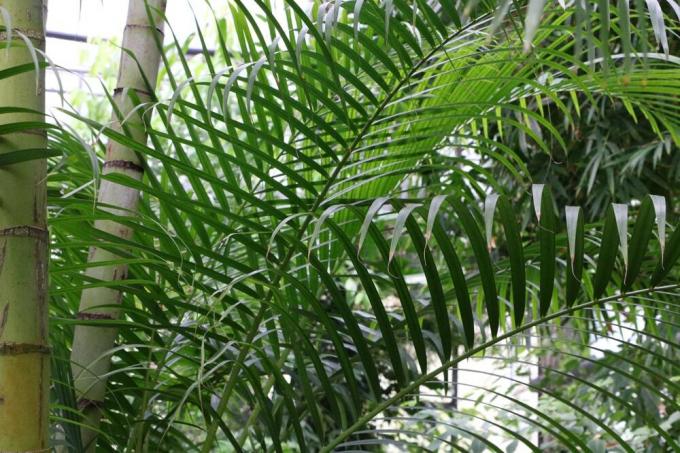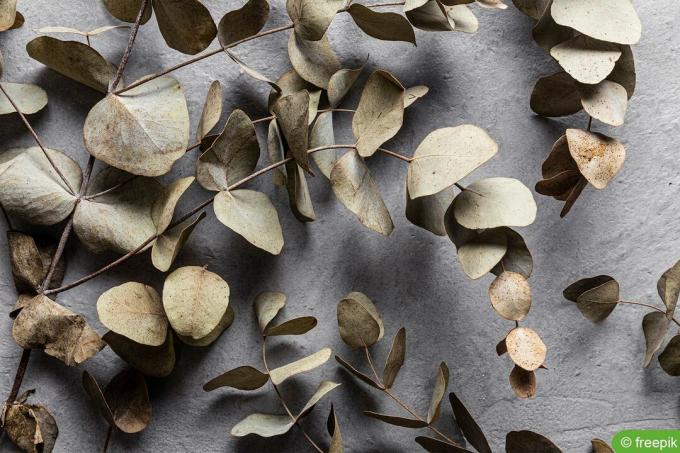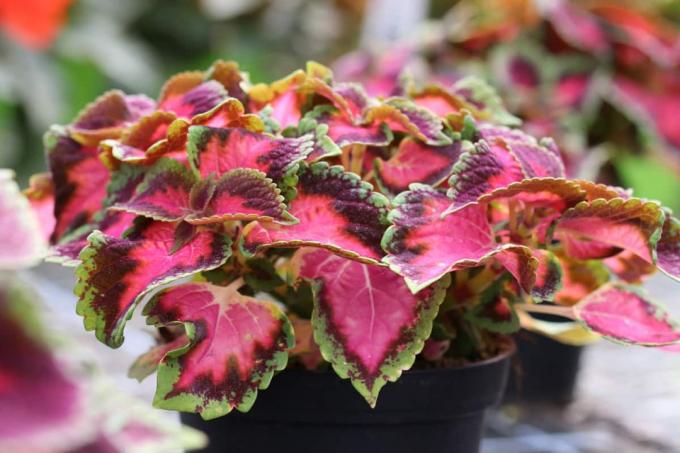

Table of contents
- frost sensitivity
- Planted palm trees
- root protection
- trunk protection
- foliage protection
- Remove antifreeze
- Conditionally hardy species
- Strong winter protection
- pot plants
- time
- Various winter quarters
- conservatory
- staircase
- Glasshouse
- basement, cellar
- Pour
- Fertilize
- Conclusion
In principle, hardy palms can overwinter outdoors. This is easily possible in mild regions. In cold regions, however, the plants do not cope well with long-lasting frosts and moisture. That is why they cannot do without good winter protection. In principle, there are various ways to overwinter hardy palm trees. Potted plants are usually overwintered differently than planted specimens. This article gives you tips on how to winterize hardy palm trees and get them well over the cold season.
frost sensitivity
For hardy palms, there is no general value for frost resistance. Each type of palm tree has an individual temperature that the plant can barely tolerate. However, these are only approximate values, which also depend on a wide variety of factors. Small and younger palm trees are more sensitive to frost, especially during long periods of frost. The roots of these palm trees do not yet reach that deep into the ground and therefore freeze faster than the long roots of older plants. Since the palm tree can no longer transport water, it will ultimately not freeze to death, but dry out.
- the roots are the most sensitive
- the trunk tolerates somewhat cooler temperatures
- the leaves are significantly less sensitive
If individual leaves die off during the winter, this is usually not a problem. The vegetation point, the so-called heart of the palm, must be protected from moisture in some palm trees.
tip 1
A palm tree evaporates water through its fronds all year round. Therefore, a functioning water balance is also important in winter.
Planted palm trees
The right winter protection for planted palm trees starts with choosing the right location. The palm should be planted as sheltered as possible from cold winds and heavy rain. There is also a good microclimate on a southern house wall. All hardy palms need a hibernation of at least three months. During this time, the plant reduces its metabolism to a minimum. In contrast to perennials, for example, their above-ground plant parts do not die off.
root protection
The roots of palm trees are particularly sensitive to moisture and cold. Therefore, they must be provided with appropriate protection early in the autumn.
tip 2
Hardy palms like the hemp palm are very sensitive to moisture. However, since autumn and winter are usually damp in our latitudes, the soil around the root area must be covered with a thick layer of bark mulch. This layer should be at least 20 to 30 cm thick.
tip 3
If the palm tree is in a place where it is exposed to the damp weather without any protection, something urgently needs to be done to prevent heavy rainfall. In this case, a light roofing makes sense.
trunk protection

Winter protection for the trunk is only necessary in the rarest of cases. Only in cool regions does it have to be wrapped in a reed or bamboo mat.
foliage protection
When the first slight minus degrees are announced, it is time to make the hardy palm tree winter-proof. The best way to protect the fronds from moisture and cold is to carefully tie them together. Although it is cold in the home of these palm trees, it is a dry cold. That is why the plants there do not need any winter protection at all. With us, however, the sensitive heart must be protected from moisture.
- carefully tie the leaves up with a coconut or sisal rope
- pad the inside (funnel) with straw
- Wrap crown with a permeable winter fleece
- Do not wrap too tightly or the fronds will snap off
- the fleece should be as light and translucent as possible
- tie together with a rope
- Tie trash bags to the top to protect against rain
tip 4
If it rains continuously, it is necessary to additionally protect the crown of leaves from moisture with a film or a waterproof bag. If the weather gets drier again, this film must be removed again, otherwise the air cannot circulate and mold and rot will form inside.
Remove antifreeze
Winter protection should be removed once temperatures warm up again. Since the leaves are not particularly sensitive to frost, this can happen early in the spring, provided the weather is not damp.
Conditionally hardy species
Palm trees that are partially hardy or plants that are planted in very cold regions should be prepared for the winter when they are planted. If this has not happened, the plant must either be dug up in the cold season and overwintered frost-free in the bucket. Alternatively, you can also help this step with a little effort.
- Excavate the soil at a distance of about 40 cm around the root ball
- Insert 5 cm thick rigid foam boards
- to all four sides
- do not lay a plate under the palm tree
- Lay a heating cable on the plates (inside) in a spiral
- heating cables for gutters or water pipes are suitable
These heating cables are usually connected to a controller that has a temperature sensor. If the temperatures drop below 5 degrees, the antifreeze kicks in. There is no risk of this heating device developing too much heat.
Strong winter protection

In particularly cold regions it may be necessary to wrap the entire palm tree in bubble wrap with particularly large air chambers. The leaves of the palm tree must first be loosely tied together.
- Wrap the sticks or slats loosely around the palm tree at a distance of 10 cm
- the film must not be attached directly to the palm
- at least a hand's breadth away
- must extend beyond the crown
- Attach the film to the frame
- install an air flap at the top and bottom
- ventilate in warmer temperatures
- Protect the root area with a thick layer of bark mulch
- possibly wrap a rope light around the trunk and lay it on the ground
- switch on in the event of frost (or set to continuous operation using the temperature sensor)
Even more protection is almost like a heated greenhouse and a lot of effort. Therefore, every hobby gardener should consider in advance whether the effort is worth it. It is easier to dig up the plant and overwinter as a container plant.
pot plants
The hibernation of hardy palm trees that are grown in pots is somewhat different. These plants do not tolerate high temperatures in their winter quarters, as it is generally too dark in living spaces. In this case, the palm trees would not hibernate and would quickly become ill or even die due to the lack of light and dry air.
time
Frost-resistant palms should stay outside for as long as possible. However, it is important that the plants are cultivated in a relatively large container that does not freeze completely so quickly. When the first light frosts appear, the bucket is placed on a styrofoam plate and insulated with two to three layers of bubble wrap. The root system of palm trees is significantly more sensitive than the parts of the plant above ground, which is why it has to be provided with winter protection relatively early on. Be sure to place the plant in a sheltered spot on a house wall.
tip 5
The potted plants need to be put away when temperatures drop below freezing for a long period of time. This is also necessary in the case of light frosts lasting for days, as there is a risk that the root ball will freeze completely. If the night temperatures drop sharply for a short time, the plants can stay outside. You can use the following temperatures as a guide, up to which the individual palm varieties are considered frost-resistant (only for a short time):
- Brahea armata (Blue Hesperid Palm): -10 degrees
- Butia paraguayensis (dwarf yatay palm): -11 degrees
- Butia yatay (yatay palm): -10 degrees
- Caryota maxima (Himalayan Fishtail Palm): -7 degrees
- Chamaerops humilis (European dwarf palm): -13 degrees
- Chamaerops humilis var. Cerifera (Blue Dwarf Palm) – 11 degrees
- Dypsis decipiens (Madagascar royal palm): -8 degrees
- Jubaea chilensis (honey palm): -15 degrees
- Phoenix canariensis (Canary Date Palm): -6 degrees
- Phoenix dactylifera (real date palm): -9 degrees
- Phoenix rupicola (rock date palm): -6 degrees
- Phoenix theophrasti (Cretan date palm): -12 degrees
- Rhapidophyllum hystix (coniferous palm): -22 degrees
- Sabal mexicana (Mexican sabal palm): -11 degrees
- Sabal minor (dwarf palmetto palm): -20 degrees
- Serenoa repens green (Green Saw Palmetto): -12 degrees
- Trachycarpus fortunei (Chinese hemp palm): -18 degrees
- Trachycarpus latisectus (windamer palm): -12 degrees
- Trachycarpus martianus (hemp palm): -8 degrees
- Trachycarpus nanus (Yunnan dwarf palm): -18 degrees
- Trithrinax campestris (Blue Needle Palm): -15 degrees
- Washingtonia filifera (Washington palm): -8 degrees
- Washingtonia robusta (petticoat palm): -7 degrees
tip 6

If you want to be sure you're timing the bucket, simply stick a minimum-maximum thermometer into the soil near the edge of the bucket. As soon as the night-time temperature falls into the minus range and does not rise back into the positive range during the day, it is time to relocate even frost-resistant palm trees.
tip 7
One of the worst mistakes that hobby gardeners can make is to place the palm tree that has been cold outside directly in the warm living room. In cool temperatures, the roots of the palm tree can hardly absorb any water. Outside, this is not a problem as the plant's metabolism is reduced to a minimum (hibernation). When clearing large tubs, it takes a long time for the root ball to warm up again. However, the leaves quickly take on the ambient temperature and evaporate more water again.
The result:
The plant suffers from a lack of water and dries up. It is even more damaging to suddenly put the palm tree back outside in the cold after a few days of getting used to it indoors.
tip 8
If you want to overwinter your hardy palm indoors due to a lack of suitable winter quarters, you should bring the plant indoors before the nights outside get cold. Once the palm tree has gotten used to the temperature drops of day and night outdoors, it can Moving to the heated apartment and the associated temperature shock put the plant in trouble bring.
tip 9
Once the hardy palm tree has been placed in the bucket, it should definitely remain there until next spring. The otherwise robust plant does not tolerate constant strong temperature fluctuations.
Various winter quarters
Hardy palm species must definitely take a vegetation break. This should last at least three months. If the palm is warm all year round, it can happen that it does not take this vegetation break until spring, when it is placed outdoors again. This can severely damage the plant, because if the metabolism is at a low level, the palm does not evaporate enough moisture in sunshine and warm temperatures and burns.
conservatory
A cool, frost-free conservatory is ideal for hardy palm trees. However, the temperatures should not be too high. About 5 to 10 degrees are ideal. The conservatory must therefore not be heated, i.e. used for residential purposes.
staircase
In a bright stairwell, the temperatures are usually moderate and the light conditions are sufficient for overwintering. However, most stairwells are quite drafty. The palm does not tolerate cold drafts well.
Glasshouse
Greenhouses are good for overwintering hardy palms. However, certain conditions must be met:
- Possibility of shading during long periods of sunshine
- Heating to prevent prolonged frosts
If the sun shines for several days or weeks in winter, a greenhouse can heat up considerably. In this case, the palm ends the hibernation and drives out again. If it then gets colder again, there is a risk of frostbite on the young shoots.
basement, cellar

Overwintering the palm is only possible in basement rooms that are cool enough. Cellars used as living space or very well insulated new build cellars are usually too warm. Temperatures around 10 degrees are ideal. However, the palm tree must not be too dark, because it does not die in winter, but only slows down its metabolism. And to do this, it needs sufficient amounts of light. In contrast to specimens that hibernate warm, the amount of light is limited.
tip 10
Install additional lighting and control it with a timer. Since few artificial light sources emit a spectrum similar to sunlight, not all types of lamps are suitable.
- Incandescent lamps: not suitable (too high proportion of red)
- Sodium vapor lamps (energy-saving lamps): only emit one wavelength, unfortunately this is not suitable for plants
- Fluorescent tubes: regardless of whether they are normal or special plant fluorescent tubes, the cold white light color emits a spectrum similar to sunlight and is therefore well suited
The lighting duration should be about 12 hours at the low light intensity.
Pour
Since the hardy palm goes dormant, it requires much less water than during the growing season. Therefore, the root ball must never be too wet. Both outdoors and in the winter quarters, watering is therefore only carried out when the soil is already loosening from the edge of the pot. With outdoor plants, make sure that they are not directly in the rain. A sheltered place under a roof protects them from waterlogging.
Fertilize
As long as the palm trees are in hibernation, they should not be fertilized. During this time, the palm hardly consumes any nutrients, so that an additional supply of nutrients would lead to an undesirably high salt and nutrient concentration in the root area. These damage the roots.
Conclusion
Making hardy palm trees winter-proof always involves a little effort. Depending on the type of palm, the plants tolerate more or less frost. However, the same applies to all palm species that the roots are very sensitive to frost. In addition, the hardy palms are sensitive to moisture, both at the roots and at the vegetation point in the crown. Therefore, the plants must be protected from moisture and ground frost.
 garden editorial
garden editorial I write about everything that interests me in my garden.
Learn more about overwintering plants

Eucalyptus dries up during the winter: what to do?
Eucalyptus in tubs spends the winter best in a frost-protected place in the house. It is not uncommon for the beautiful eucalyptus plants to dry up during the winter. We show what you can do about it.

Is bamboo hardy? Hibernate bamboo correctly
A bamboo can undoubtedly enrich any garden. But can it survive winter temperatures in good health? There is no general answer. It depends on the species and what winter protection it gets.

Is the colored nettle hardy? 6 tips for wintering
Summer is the season when the colors of these ornamental foliage plants are at their most intense. Most of the leaves are multicolored, with different drawings, wavy or heavily slit edges.

Is Camellia japonica hardy? Overwinter camellia properly
Anyone who sees a blooming camellia for the first time will definitely be amazed. The attractive plant, which came to Central Europe from Japan and Korea, has taken the hearts of hobby gardeners by storm. It is usually cultivated in tubs. Is she hardy?

Is the magic flower hardy? | Overwinter Mirabilis jalapa
The Japanese miracle flower (Mirabilis jalapa) delights its viewers with its bright and colorful flowers from June to October. It carries up to five different colored flowers on one and the same plant. Even a single flower can be multicolored.

Is rhododendron hardy? 6 tips for wintering
Overwintering rhododendrons: With these 6 tips you can get the azaleas through the winter safely!
